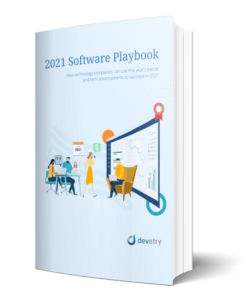2021 Buying & Consumer Trends Every Tech Company Needs to Know
Leadership
2022-05-09T19:25:58.313Z
When something as disruptive as a pandemic happens in a year, buying and consumer trends will shift, many permanently.
Between lack of confidence in the markets and a record-high unemployment rate, people have held their money closer to their chests.
This is not to suggest we can’t still earn their business, but perhaps that we should work differently for it.
B2B vs. B2C: While companies and individuals spend their money on wildly different things, trends typically run parallel to one another. Whether your digital product is purchased and used by a parent, freelancer, or multi-billion dollar company, you’re connected to disruptions via a complex web of cause and effect.
Here are the major buying and customer trends that you need to consider now and well into 2021.
Customer Confidence is Volatile
If an individual is fearful of losing their job, there are a few possible scenarios:
- They will freeze all “additional” spending. No extras or upgrades.
- They will cancel anything deemed unnecessary. This may include technology and software services.
Of courses, the same goes for businesses of all sizes.
This uncertainty varies across industries, regions, and demographics. Prior to the pandemic, if you tracked upsell rates, closing rates, average budgets, percentage of discretionary spending, and ROI, then you can continue tracking these and identify when this ambiguous “uncertainty” has peaked, dropped, or returned to normal.
Will a vaccine help? With a vaccine is on the horizon, consumer confidence has certainly improved in recent weeks. However, it’s heavily dependant on FDA approvals, whether consumers will sign up to vaccinate, and the damage that occurs before meaningful vaccination rates. If you’re a business, hope for the best–plan for the worst.
Shrinking Disposable Income
The spring stimulus and enhanced unemployment checks helped consumer’s bank accounts. However, despite there being talks of other stimulus packages, it’s not looking good. And while employment is gradually ticking up, there are millions without jobs.
In fact, in October 2020, the New York Times reported that 8 million people have slipped into poverty since the beginning of the pandemic. 🤯
With so many consumers facing low or no income, their buying power is greatly diminished.
This phenomenon is affecting blue-collar workers at much higher rates than white-collar workers, so any software company serving this demographic has already had to adapt. However, these ripples are still making waves throughout the economy, and dominoes can still fall for software companies serving a seemingly unaffected group.
Cost-Cutting Has Increased Customer Churn
Customer churn is the rate at which users stop doing business with you. To be successful, your growth rate needs to exceed your churn rate. However, for many businesses, that’s not happening.
To find your churn rate, you need to know the percentage of subscribers that cancel within a given time, likely 30 days and one year. By tracking that, you can see trends and align them with market and economic changes.
Gen Z is Here
 Gen Z, defined as anyone born after the year 1996, has entered the workforce and buying market. According to Pew Social Trends, here are some things we know about this generation:
Gen Z, defined as anyone born after the year 1996, has entered the workforce and buying market. According to Pew Social Trends, here are some things we know about this generation:
- 1 in 4 is Hispanic
- They are more racially and ethnically diverse than any other generation before them
- They are progressive and pro-government
- They are more likely to enroll in college and post-secondary education than all generations before them
- They are concerned about environmental issues, particularly climate change
- They are socially and politically liberal
- They have higher rates of suicide, depression, and anxiety compared to other generations
And possibly most relevant to you, 95% of Gen Z has a smartphone.
48% say that they’re online “almost constantly,” with the top platforms being social media and entertainment.
85% of Gen Zers use YouTube, 72% Instagram, and 69% Snapchat.
Otherwise known as “digital natives,” this group uses technology constantly, sometimes taking for granted growth and limitations of networks, processing power, and data. They expect slick user interfaces, speed, and personalization from their applications and cloud-based software.
Investing in Diversity
If you look at Google Trends beginning on June 1, 2020, you’ll see a massive spike in queries like “black-owned businesses.” However, this 300% increase is followed by a steep and steady decline. Once we arrived in October 2020, most of the interest (and guilt) had completed faded.
However, any business leader would be foolish to think spikes like these won’t happen again (and hopefully someday, maintain a baseline).
Since buyers vote with their dollars, every business, with every demographic, needs to invest in diversity.
Health & Home
The pandemic has shined a spotlight on health and the healthcare ecosystem. At the same time, it has forced millions of people to stay in their homes, removing commutes, offices, and weekend events.
While these two trends–health and home–may be winding down comparatively, they will remain elevated for the next year or two. What does that mean for businesses?
In short, the consumers (that are able to) are willing to spend more time and more money on things that improve their:
- Health
- Access to health
- Their friends and families health
- Home
- Access to home buying opportunities
Seasons & Seasonality
“You can’t watch the news literally anywhere without seeing giant fires and storms happening on a regular basis,” Stephen Schwarzman
For the past few decades, seasons (and seasonality) have hummed along in the same order, with the same cadence. But with schools closed, vacations delayed, and natural disasters abound, there is a case to be made for seasonal blur. Therefore, if you’re in an industry that could be affected by continued climate change or seasonal shift, you may need to adapt.
 How to Leverage 2021’s Buying & Consumer Trends
How to Leverage 2021’s Buying & Consumer Trends
We break down these buying and consumer trends even more in our 2021 software playbook. To understand the strategies around the trends above and executive insight into each, download the playbook!